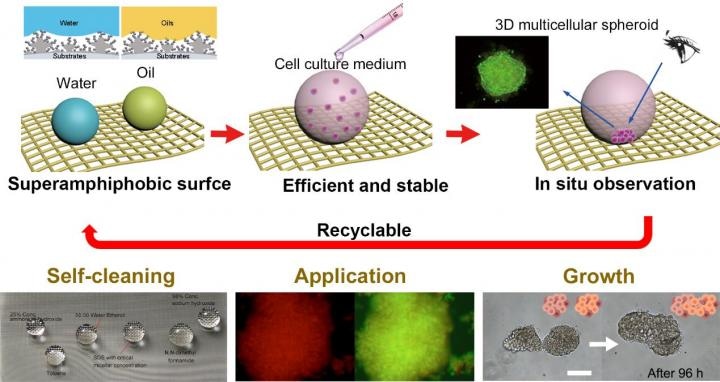Aug 6 2019
Conventional techniques for in-vitro biological assessments were typically conducted on 2D monolayer cell culture. In these systems, the rigorous spatial interactions between cells were completely ignored, which might result in information loss and inaccurate results.
 Schematic image of upward culture process of 3D multicellular spheroids on durable superamphiphobic silica aerogel surface. The antifouling surface kept cell from adhering and triggered cell self-organization into spheroids. The spheroids can be long-term incubated and in-situ observed on the surface. (Image credit: ©Science China Press)
Schematic image of upward culture process of 3D multicellular spheroids on durable superamphiphobic silica aerogel surface. The antifouling surface kept cell from adhering and triggered cell self-organization into spheroids. The spheroids can be long-term incubated and in-situ observed on the surface. (Image credit: ©Science China Press)
3D cellular spheroids culture provides a chance to imitate physiological conditions with heterogeneous spatial distribution pattern of oxygen, signal molecules, and nutrients metabolites, which is a suitable model for cell research.
The arrival of 3D cellular spheroids is of great importance for the examination of drug evaluation, regenerative medicine, tumor developing mechanism, and stem cell differentiation.
For the production of spheroids, the standard principle is cell self-organized on a biomaterial surface that cells cannot attach and therefore are pushed to interact with each other. To realize this, many fabrication methods have been proven previously. Among them, significant examples are NASA bioreactors, low-adhesion matrix, hanging-droplets culture, and magnetic manipulation. These approaches pave the way for applications of spheroids.
Regrettably, such advanced approaches necessitate specialized technologies, time-consuming process, labor-intensive handing, and most of them are incapable of in-situ observation. Therefore, it is pressing to develop a new culture technique that is safe, efficient, and capable of in-situ observation.
In a study article published recently in National Science Review, the research team headed by Professor Qing-hua Lu suggested an innovative upward culture of 3D multicellular spheroids on a tough superamphiphobic surface (SSAS).
Rich hierarchical structures and chemical inertness were built on the antifouling surface, resulting in very low solid-liquid adhesion for a series of liquids with various surface tensions spanning from water to n-dodecane. The SSAS displayed long-term mechanical and thermal stabilities. Such a robust durable SSAS meets the demands for long-term upward culture of 3D cell spheroids.
Compact 3D cell spheroids with a stable cell population were created with the help of gravity and droplet curvature in the quasi-spherical droplets of the medium. Set apart from other approaches, this technique is biocompatible, more efficient, reproducible and capable of in-situ observation. The possible applications in spheroidal fusion, drug screening, and long-term tracing have been shown by the authors.
Remarkably, no treatment is required for recycling this surface. The described SSAS provides a new technological space for stem cell differentiation, in-vitro research of drug screening, and spheroid fusion.